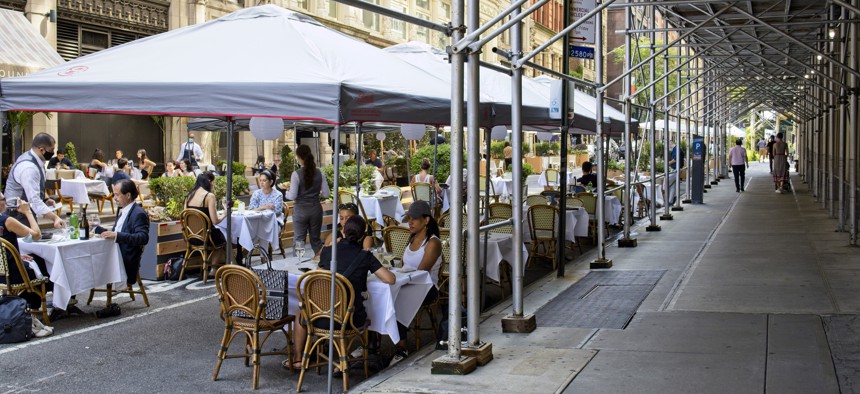Restaurants Urge Mayors to Extend Outdoor Dining Through Winter

iStock.com/Warren Eisenberg
The National Restaurant Association sent a letter to the U.S. Conference of Mayors warning that thousands more restaurants could close without support to keep outdoor dining going.
The National Restaurant Association sent a letter this week to the U.S. Conference of Mayors warning that the industry is in a dire situation, and that many full-service restaurants could close without extending outdoor dining through the winter months.
While outdoor dining "provided a lifeline" for restaurants this summer, the outlook for the restaurant industry remains grim, the association wrote. Numerous restaurants benefited from the federal Restaurant Revitalization Fund, but the application portal closed July 14 because demand quickly out paced the funds available. The association said two-thirds of applicants didn't receive any money, leaving a $43.6 billion funding gap and 177,000 restaurants in danger of closing.
The American Rescue Plan Act established the Restaurant Revitalization Fund to help restaurants and other businesses keep their doors open. The program will provide restaurants with funding equal to their pandemic-related revenue losses up to $10 million per business and no more than $5 million per physical location. Recipients are not required to repay the funding as long as the cash is used for eligible uses no later than March 11, 2023.
The pandemic has cost restaurants and bars upwards of $300 billion in lost sales. More than 370,000 applicants requested more than $76 billion of relief within the first two and half weeks that the RRF portal opened—far more than the $28.6 billion allotted to the program, according to the Conference of Mayors.
More Challenges for Restaurants
The restaurant association said its research shows that:
- In recent weeks, the coronavirus delta variant slowed indoor dining at 78% of restaurants nationwide.
- 20% of diners prefer to eat outside.
- At 68% of full-service restaurants, outdoor dining is 20% or more of daily sales.
- Slightly more than 60% of restaurants can only use their outdoor space through October.
- Only 30% of eateries plan to utilize outdoor seating the entire winter.
Meanwhile, some cities are requiring restaurant patrons to be vaccinated. For example, New York City wants proof of Covid-19 vaccination for entry to restaurants, as well as San Francisco, New Orleans and other cities. Independent Restaurant Owners Association Rescue in New York City and other businesses argue in a lawsuit that the mandate arbitrarily singles out certain types of businesses and provides no alternative for workers and customers who chose not to get vaccinated.
Last year, many restaurants invested in equipment to expand and winterize their outdoor dining areas. “Restaurants currently rely on outdoor dining to stay open, but the dark chill of winter is coming,” Mike Whatley, vice president for State Affairs and Grassroots Advocacy, said in a statement. “For operators depending on this revenue, every additional day they can extend their outdoor service matters.
The association's letter encourages local leaders to extend expanded outdoor dining allowances, continue to streamline permitting processes, promote outdoor dining efforts by restaurants in their localities, and provide funding for outdoor dining infrastructure as some did last year.
The Conference of Mayors did not specifically answer Route Fifty's questions about the restaurant association's letter, but pointed to its 2021 adopted resolutions that "call on cities to support the passage of the bipartisan Restaurant Revitalization Fund Replenishment Act, which would add $60 billion in targeted relief" for struggling restaurants.
The mayors also are urging the Biden administration and Congress to work directly with them and local executives to "ensure these funds are directly accessible to the small business across our communities."
Early Restaurant Accommodations
Early into the pandemic, cities took a number of steps to allow restaurants greater flexibility, doing everything from blocking off streets for dining, to allowing the sale of alcoholic drinks to go. On-street parking typically has been a highly coveted commodity, but cities closed streets and repurposed curbside parking into parks, outdoor dining or space for outdoor markets to allow for social distancing.
To embrace change in the long term, a Transportation for America report suggests cities could streamline the permitting process for small businesses to set up curbside, or create short-term loading zones that could be used by food delivery drivers or others to free up curb space elsewhere.
Jean Dimeo is managing editor of Route Fifty.
NEXT STORY: A Breakdown of the Black-White Homeownership Inequality Gap





